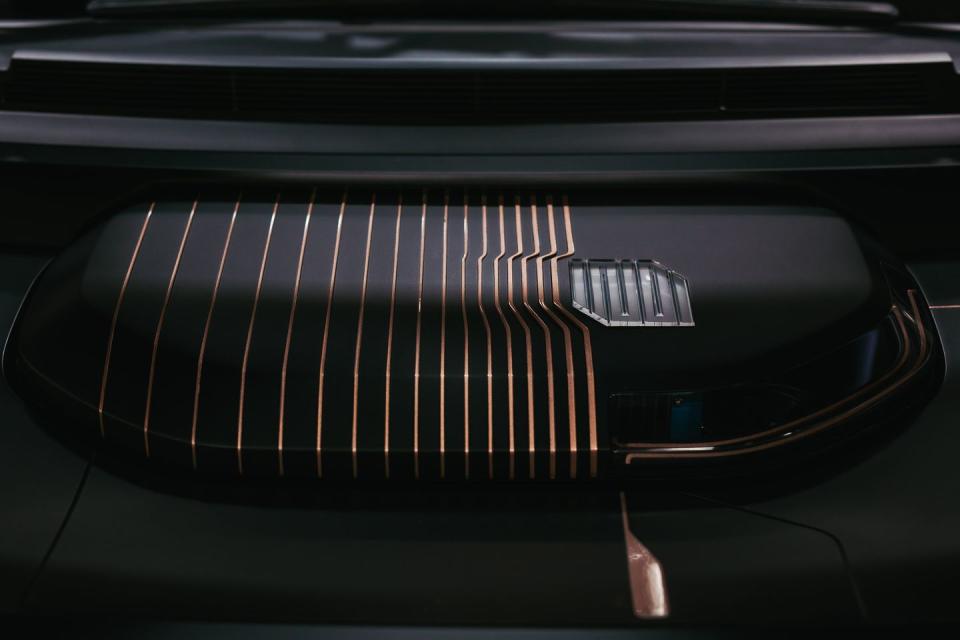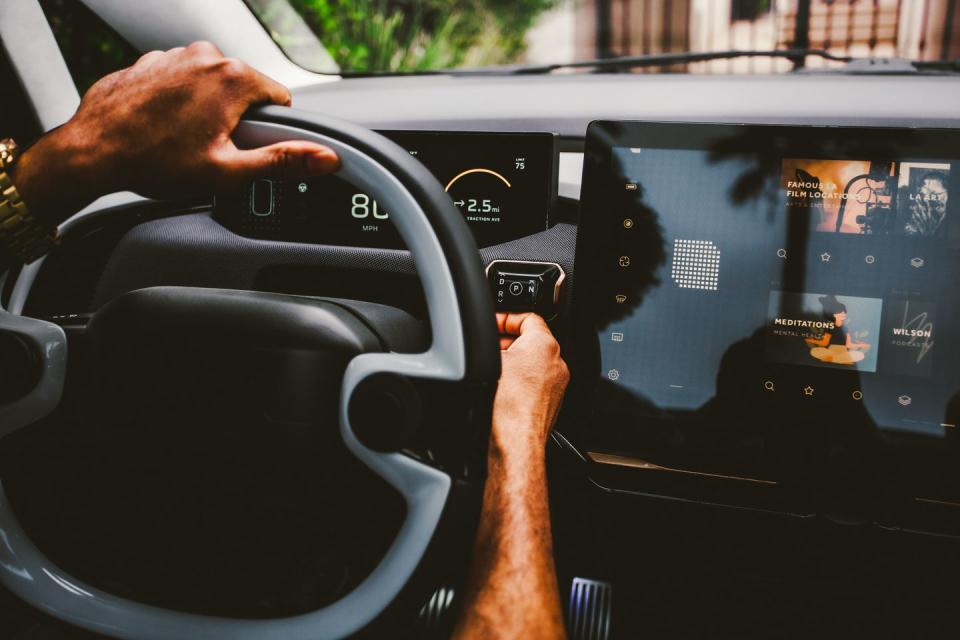Can INDI EV Make an Electric Car?

INDI EV, a Southern California startup, says it will have a production electric car in showrooms within two years using an adjustable air-ride suspension, all-wheel drive, and a 95-kWh battery.
The main draw, however, will be a computer aimed at onboard gaming.
Pricing will range from $45,000 to $65,000.
INDI EV is coming and will have a car in showrooms in less than two years, the company says.
Wait, what is INDI EV, you ask?
INDI EV is a startup carmaker headquartered in Southern California that is aiming to make an electric crossover called the INDI ONE. It will seat five and will be sized between the Tesla Model Y and Model X. It will ride on an adjustable air-ride suspension with all-wheel drive and be powered by a 95-kWh battery giving it a range of either 275 or “a little bit over 300 miles,” depending what part of the press material you read or whom you ask.
How is that different from Aptera, Fisker, Karma, Canoo, Faraday Future, Byton, and all the other EVs that all the other startups are claiming they’re going to make?
Gaming.
The execs at INDI EV seem to want to separate their product from the field at this very early stage by saying it has a “supercomputer” under the hood. They even named the supercomputer VIC, or Vehicle Integrated Computer.

“The INDI ONE is unique from other electric vehicles in the space thanks to its VIC (Vehicle Integrated Computer), the first ever in-vehicle integrated supercomputer,” says INDI EV.
VIC sits in the spot under the hood where the internal combustion engine would be on a more traditional car. You know that VIC is sitting in there because the hood has a glass window in it specifically placed there so you can see VIC. Now, what makes VIC a supercomputer? Here’s where we encounter what is sometimes referred to as “marketing hype.” If asked specifically, INDI EV will admit that the “supercomputer” is really a Windows PC with an i7 processor running an Nvidia GeForce RTX 2080 graphics card. Ask any teenager and they’ll tell you something like, “Yeah, that’s a pretty good gaming setup.” Ask any supercomputer-using rocket scientist and they’ll tell you, “Get the heck outta here!”
Even Wikipedia will tell you that a supercomputer is exponentially bigger and far more powerful than a mere gaming computer meant to play Mario Kart:
“The performance of a supercomputer is commonly measured in floating-point operations per second (FLOPS) instead of million instructions per second (MIPS). Since 2017, there are supercomputers which can perform over 1017 FLOPS (a hundred quadrillion FLOPS, 100 petaFLOPS or 100 PFLOPS).”
So, INDI EV, that ain’t no supercomputer you got there.
If they’re wildly exaggerating about the computer, are they also wildly exaggerating about everything else? Well, maybe not. INDI EV’s founder is a video gaming entrepreneur so offering a gaming computer in the car would seem only natural.
“The idea from us at the beginning was, ‘How do we take this EV platform and do something more with it? What’s the next-generation usage?” asked head of product design Andre Hudson. “So we like to think that the next matrix of performance in the car is not going to be that horsepower, it’s not going to be the speed and the torque, it’s going to be the processing power, because you’re sitting on top of this high-voltage system which is allowing you to create this hardware set, this fundamental toolbox of digital components to not only let us offer a unique feature set with what you can do with that hardware, but also keep it open source and let people come in and create applications on top of it. And that is like a really totally different thinking for EVs.”

The vehicle control system will be run in parallel but it will use Linux, for security purposes.
“VIC is the core of our car. And again, as I said, what’s been cool about this is that it’s allowed us to create some amazing capabilities for archiving for social for video, for photo, or for video work conferencing. Of course, people can also use the standard Windows applications on it for creative production. But also, it allows us to go into gaming, which is what our background is.”
And for the record, the gaming is not planned for the driver to do while driving, just the passengers. There is no self-driving in the INDI ONE. At least not yet.
Another thing that sets INDI EV apart from competitors is that its corporate structure is farmed out. Its R&D headquarters is in the industrial city of Vernon, California, where approximately 70 employees work on the motor and the battery.

“How the business operation was structured from the beginning was that leads were put in place for all of the commodity areas, and then we manage exterior engineering partner resources for R&D, globally,” said Hudson, our guide for a walk-around of the INDI ONE. “We’ve worked with German design companies, Tata in India, companies in Korea, we manage those partners which in each of those areas there is between 10 to 35 people working in each of those commodities.”
So, for much of the car, INDI EV is sourcing parts from around the world.
“It’s been quite an involved undertaking because we’ve actually developed our sub-chassis ourselves and we’re packaging a powertrain that you buy off the shelf as far as the EDU (electric drive unit) goes. We develop our battery in-house.”
Since the company’s founding in 2017, it has produced a number of prototypes, including the one I got to sit in—but not drive. There is plenty of room in every dimension, from head and elbow room to knee and leg room. There are three screens on the dashboard: a smallish one in front of the driver for a speedo and range gauge, and two 15-inch screens to the right. The rightmost screen is for the passenger. INDI EV is in negotiations to get the same kind of viewing screen that Mercedes offered at one point that allowed passengers but not the driver to see movies while underway. The center screen is for infotainment and NAV, the traditional items found on modern automotive dashboard screens. It will be controlled by a scrolling mouse-like knob, but it was not functional for a demo when I was there. The scroller knobs were also on the steering wheel to control cruise control and audio, among other tasks.
Up above was a large glass roof that ran the length of the vehicle. Solar gain will be controlled by “the latest UV tech,” Hudson promised. The seats in the demo unit I saw were slathered in Alcantara, but a traditional cloth trim will be available at some point.
The center armrest held a cooler/fridge that fits up to four cans of your favorite beverage. There was also a wireless phone charger and numerous USB ports. Several cameras allow you to record video of, say, your kids being cute in the back seat or, for spectacular drives up PCH, you can record your drive from exterior cameras. Cameras are activated via voice control.

The tailgate was way too low when opened in the prototype but is supposed to be higher-opening in production units.
Overall it was impressive, especially for the starting price of $45,000. Even a loaded INDI ONE will go for just $65,000. That may be the most impressive thing about the INDI ONE, whenever it gets built.
“You know, I think the product we have is truly something different, if people get it,” said Hudson. “Right now, you know, we're in a transitional phase of bringing in investors. To the next phase, I think the potential is there, we can do it… The EV is not going to be about just speed anymore. It's not going to be so much about range, though that will continue to matter. What that can be is a workhorse as a digital component, and that's really what this thing is about. And it's the first to come at it from that direction.”
What do you think about an EV built around a gaming computer? And if you have ideas for other kinds of feature sets to run off the fundamental EV hardware, share them in the comments below.
